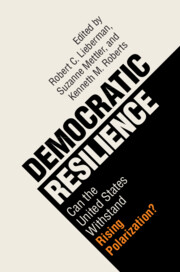39 results
Virtual Issue: Race in the United States in Social Science History
-
- Journal:
- Social Science History , First View
- Published online by Cambridge University Press:
- 19 April 2024, pp. 1-8
-
- Article
-
- You have access
- HTML
- Export citation
Compared to what?: Setting American political development in comparative context
-
- Journal:
- Social Science History / Volume 48 / Issue 2 / Summer 2024
- Published online by Cambridge University Press:
- 11 March 2024, pp. 361-382
- Print publication:
- Summer 2024
-
- Article
-
- You have access
- Open access
- HTML
- Export citation
Daniel Carpenter’s Democracy by Petition: A Symposium Introduction
-
- Journal:
- Social Science History / Volume 47 / Issue 1 / Spring 2023
- Published online by Cambridge University Press:
- 10 November 2022, pp. 145-147
- Print publication:
- Spring 2023
-
- Article
-
- You have access
- Open access
- HTML
- Export citation
Acknowledgments
-
- Book:
- Democratic Resilience
- Published online:
- 20 November 2021
- Print publication:
- 25 November 2021, pp xviii-xx
-
- Chapter
- Export citation
Contributors
-
- Book:
- Democratic Resilience
- Published online:
- 20 November 2021
- Print publication:
- 25 November 2021, pp xii-xvii
-
- Chapter
- Export citation
Part III - Social Polarization and Partisanship
-
- Book:
- Democratic Resilience
- Published online:
- 20 November 2021
- Print publication:
- 25 November 2021, pp 169-264
-
- Chapter
- Export citation
Figures
-
- Book:
- Democratic Resilience
- Published online:
- 20 November 2021
- Print publication:
- 25 November 2021, pp ix-x
-
- Chapter
- Export citation
Contents
-
- Book:
- Democratic Resilience
- Published online:
- 20 November 2021
- Print publication:
- 25 November 2021, pp vii-viii
-
- Chapter
- Export citation
Part IV - Vicious Circles? The Relationship between Polarized Behavior and Institutions
-
- Book:
- Democratic Resilience
- Published online:
- 20 November 2021
- Print publication:
- 25 November 2021, pp 265-340
-
- Chapter
- Export citation
Part V - Can Political Action Save Democracy in Polarized Times?
-
- Book:
- Democratic Resilience
- Published online:
- 20 November 2021
- Print publication:
- 25 November 2021, pp 341-400
-
- Chapter
- Export citation
Copyright page
-
- Book:
- Democratic Resilience
- Published online:
- 20 November 2021
- Print publication:
- 25 November 2021, pp iv-iv
-
- Chapter
- Export citation
1 - How Democracies Endure
- from Part I - Why Might Polarization Harm Democracy?
-
-
- Book:
- Democratic Resilience
- Published online:
- 20 November 2021
- Print publication:
- 25 November 2021, pp 3-34
-
- Chapter
- Export citation
Part I - Why Might Polarization Harm Democracy?
-
- Book:
- Democratic Resilience
- Published online:
- 20 November 2021
- Print publication:
- 25 November 2021, pp 1-92
-
- Chapter
- Export citation
Dedication
-
- Book:
- Democratic Resilience
- Published online:
- 20 November 2021
- Print publication:
- 25 November 2021, pp v-vi
-
- Chapter
- Export citation
Index
-
- Book:
- Democratic Resilience
- Published online:
- 20 November 2021
- Print publication:
- 25 November 2021, pp 401-406
-
- Chapter
- Export citation
Part II - Political Institutions in Polarized Times
-
- Book:
- Democratic Resilience
- Published online:
- 20 November 2021
- Print publication:
- 25 November 2021, pp 93-168
-
- Chapter
- Export citation
Tables
-
- Book:
- Democratic Resilience
- Published online:
- 20 November 2021
- Print publication:
- 25 November 2021, pp xi-xi
-
- Chapter
- Export citation

Democratic Resilience
- Can the United States Withstand Rising Polarization?
-
- Published online:
- 20 November 2021
- Print publication:
- 25 November 2021
“The Latter-Day General Grant”: Forceful Federal Power and Civil Rights
-
- Journal:
- Journal of Race, Ethnicity and Politics / Volume 6 / Issue 3 / November 2021
- Published online by Cambridge University Press:
- 03 August 2020, pp. 529-564
-
- Article
- Export citation
Disenfranchising Democracy: Constructing the Electorate in the United States, the United Kingdom, and France. By David A. Bateman. Cambridge: Cambridge University Press, 2018. 348p. $99.99 cloth, $29.99 paper.
-
- Journal:
- Perspectives on Politics / Volume 18 / Issue 2 / June 2020
- Published online by Cambridge University Press:
- 02 June 2020, pp. 624-626
- Print publication:
- June 2020
-
- Article
- Export citation

